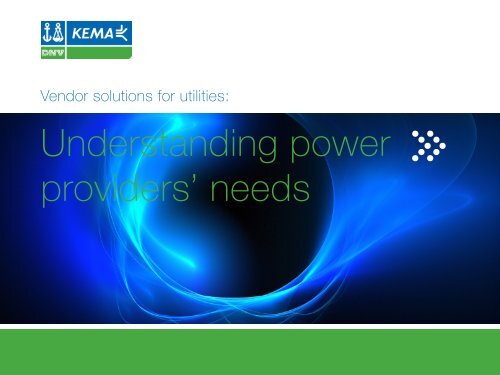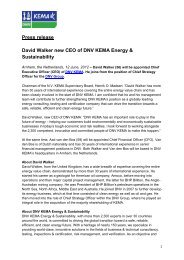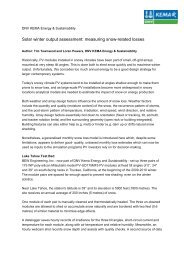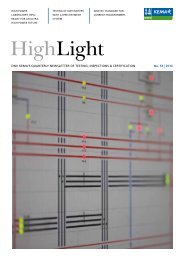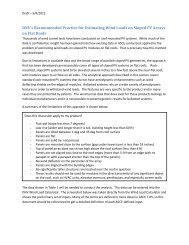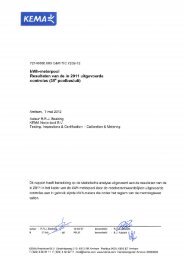Download PDF - Smart Grid Sherpa
Download PDF - Smart Grid Sherpa
Download PDF - Smart Grid Sherpa
You also want an ePaper? Increase the reach of your titles
YUMPU automatically turns print PDFs into web optimized ePapers that Google loves.
Vendor solutions for utilities:<br />
Understanding power<br />
providers’ needs
Understanding power providers’ needs is key – it’s about more than just good technology<br />
Challenges facing utilities<br />
Aligning your technology with a specific business case<br />
Technologies lead to functions lead to benefits lead to value<br />
Testing and real-world pilot installations reduce perceived risk<br />
Summary: five points vendors should consider<br />
1<br />
Understanding needs<br />
3 Developing a business case 5<br />
Testing and pilots<br />
2<br />
Utilities’ challenges<br />
4 Functions, benefits, value<br />
6<br />
Five points<br />
www.dnvkema.com
UNDERSTANDING NEEDS<br />
Understanding power providers’ needs is key —it’s about more than just<br />
good technology<br />
The <strong>Smart</strong> <strong>Grid</strong> arena is currently crowded with companies, both<br />
familiar and those new to the power industry, offering technologies<br />
and solutions that are promised to be the answer for utilities, intensive<br />
energy users, and other industry stakeholders. Utilities are businesses<br />
with the same responsibilities to shareholders and bottom lines that any<br />
other business has — they just also happen to have the requirement<br />
of reliability and quality to think about. After all, a power outage can<br />
impact millions of people and businesses. Many energy producers/<br />
users are overwhelmed with the available technology options, and<br />
might be tempted by one-stop-shop purchases. However, given the<br />
complexity of this new era, clear, structured connections between<br />
these technologies and their applications — specifically the impact<br />
these technologies will have on the business of producing energy —<br />
are necessary. It is not a surprise then that utilities want assurance that<br />
their investments will offer clear benefits and cost-savings. Vendors<br />
must help them understand how a technology will play a risk-free<br />
role, and how it fits into the utilities overall <strong>Smart</strong> <strong>Grid</strong> strategy.<br />
A vendor’s <strong>Smart</strong> <strong>Grid</strong> Strategy should include:<br />
» Business benefits<br />
» The elements and functionalities that need to be validated<br />
» The processes required to ensure that deployment would provide<br />
true value to the utility and end users<br />
Only if these three pieces are coordinated can potential <strong>Smart</strong> <strong>Grid</strong><br />
benefits be realized.<br />
1<br />
2<br />
Understanding needs<br />
Utilities’ challenges<br />
3 Developing a business case 5<br />
4 Functions, benefits, value<br />
6<br />
Testing and pilots<br />
Five points<br />
www.dnvkema.com<br />
1
UTILITIES’ CHALLENGES<br />
Challenges facing utilities<br />
Utilities are facing a number of challenges that vendors new to the<br />
power industry should have a firm grasp on, both in terms of dayto-day<br />
operations and future <strong>Smart</strong> <strong>Grid</strong> implementations. Vendors<br />
who position their technologies as a solution to a specific challenge<br />
will be met with more openness to initial engagement. While<br />
specific challenges vary a great deal regionally, the following are a<br />
few examples.<br />
Aging infrastructure<br />
In most developed countries, power grid assets are getting old.<br />
In the United States, for example, transformers that were installed<br />
in the 60s and 70s are often in use today. While utilities and<br />
power providers are interested in upgrading their systems, this is a<br />
gradual process, and any new installations need to coexist with those<br />
old components.<br />
Interoperability<br />
In addition to working with existing infrastructure, smart technologies<br />
added to the grid need to work with one another, including across<br />
vendors and across borders—an issue particularly pronounced in<br />
Europe. Given today’s lack of universal standards for <strong>Smart</strong> <strong>Grid</strong><br />
communications, utilities need to feel confident that a given vendor’s<br />
technology is flexible enough to communicate with the rest of their<br />
<strong>Smart</strong> <strong>Grid</strong> developments.<br />
Shifting regulatory environments<br />
Because the <strong>Smart</strong> <strong>Grid</strong> is a young market, the regulatory environment<br />
still has a great deal of uncertainty. Many regions do not have<br />
detailed, concrete regulations in place. Those who have begun the<br />
regulatory process are still trying to determine what measures are<br />
most effective. Utilities are working in a world of shifting expectations,<br />
and vendors need to understand and speak to the specific regulatory<br />
challenges that a potential customer is facing.<br />
1<br />
2<br />
Understanding needs<br />
Utilities’ challenges<br />
3 Developing a business case 5<br />
4 Functions, benefits, value<br />
6<br />
Testing and pilots<br />
Five points<br />
www.dnvkema.com<br />
2
DEVELOPING A BUSINESS CASE<br />
Aligning your technology with a specific<br />
business case<br />
The entire <strong>Smart</strong> <strong>Grid</strong> system and deployment go beyond technology<br />
alone—a fact vendors need to understand that in order to be<br />
successful. Those vendors who have successfully broken into the<br />
market have recently understood the need to sell-in solutions, rather<br />
than technology. A utility’s <strong>Smart</strong> <strong>Grid</strong> strategy takes into account<br />
all the processes, people and organizational changes that have to<br />
occur in order to achieve expected benefits. For example, while<br />
many new technologies enable two-way communication (potentially<br />
resulting in benefits such as self-healing networks and customer<br />
empowerment), the reality is that business benefits like shaved peak<br />
demand or reduced system interruption cannot be achieved without<br />
substantial investment in business process reengineering as well<br />
as integration with legacy systems. Taking advantage of possible<br />
benefits requires a significant capital expense above and beyond<br />
the cost of the technology solution. Vendors attempting to enter<br />
the energy market must not only understand these deeper utility<br />
operations, they need to help utilities envision the path for optimizing<br />
the use of a new technology. This can be a daunting task for many<br />
vendors to undertake – there are a number of companies, including<br />
DNV KEMA, who offer consulting services to help vendors tackle that<br />
very problem.<br />
1<br />
2<br />
Understanding needs<br />
Utilities’ challenges<br />
3 Developing a business case 5<br />
4 Functions, benefits, value<br />
6<br />
Testing and pilots<br />
Five points<br />
www.dnvkema.com<br />
3
FUNCTIONS, BENEFITS, VALUE<br />
Technologies lead to functions lead to benefits<br />
lead to value<br />
Many vendors talk about the specific functions their technologies can bring to a<br />
utility’s infrastructure. However, utilities are not necessarily interested in the function<br />
of a technology — functionality is just a means to an end. Instead, they care about<br />
the ultimate benefit that functionality offers them, and how that benefit translates<br />
into value.<br />
Take as a simple example a Distribution Automation provider that may have a fault<br />
location, isolation, and service restoration solution. The table to the right outlines<br />
potential functions, benefits, and value might look like this.<br />
Functions Benefits Value<br />
• Devices quickly<br />
detect line faults<br />
• System<br />
incorporates meter<br />
data and customer<br />
calls for outage<br />
verification<br />
• System allows<br />
switching for<br />
fault isolation<br />
and service<br />
restoration<br />
• Devices quickly<br />
detect line faults<br />
• System incorporates<br />
meter data and<br />
customer calls for<br />
outage verification<br />
• System allows<br />
switching for fault<br />
isolation and service<br />
restoration<br />
• Improved system<br />
reliability<br />
• Improved electricity<br />
service time<br />
• Reduced outage<br />
time<br />
• Improved service<br />
response efficiencies<br />
Utility<br />
• Increased revenue<br />
• Reduced penalties<br />
• Improved customer<br />
satisfaction<br />
End customer<br />
• Reduced downtime<br />
for increased<br />
productivity/<br />
revenue<br />
• Satisfaction in<br />
electricity service<br />
provider<br />
• Reliability in<br />
service provider<br />
for efficiency<br />
1<br />
2<br />
Understanding needs<br />
Utilities’ challenges<br />
3 Developing a business case 5<br />
4 Functions, benefits, value<br />
6<br />
Testing and pilots<br />
Five points<br />
www.dnvkema.com<br />
4
TESTING AND PILOTS<br />
Testing and real-world pilot installations<br />
reduce perceived risk<br />
Implementing a new, unproven technology onto an existing grid<br />
infrastructure is a risky prospect for a utility; if the system goes down,<br />
countless people can be affected. However many vendors are in<br />
the position of needing to sell unproven technology. Until a vendor<br />
is able to prove that its technologies are reliable and will work within<br />
the existing grid infrastructure, it will face reluctance from utilities<br />
to incorporate that technology. There are two key components<br />
to demonstrating real-world reliability: pilot installations and<br />
extensive testing.<br />
Pilot Projects<br />
Pilot projects are the next step in the validation process. Before utilities<br />
will make the investment to install a new technology across their<br />
entire grid infrastructure, they will want to see a real-world installation<br />
project. As comprehensive as testing has become, there are always<br />
unanticipated variables that can arise on a real grid. Vendors who<br />
go into a pitch with the understanding that a pilot project might be<br />
necessary, and a general plan for what that pilot might look like, will<br />
have a leg up on their competitors.<br />
1<br />
2<br />
Understanding needs<br />
Utilities’ challenges<br />
3 Developing a business case 5<br />
4 Functions, benefits, value<br />
6<br />
Testing and pilots<br />
Five points<br />
www.dnvkema.com<br />
5
TESTING AND PILOTS<br />
Testing<br />
There is a wide range of testing that needs to be undertaken before a utility will accept a new<br />
technology. While the specifics of each test will vary from region to region, utility to utility,<br />
and technology to technology, there are a number of standard testing themes that utilities<br />
are interested in. First and foremost, utilities need assurance that the technology can handle<br />
whatever power load they would be subjected to, both sustained and power spikes. Utilities<br />
will also want to see how these technologies react to fluctuations in the grid, and how well they<br />
integrate with other technologies. And finally, utilities will want to ensure that the technologies<br />
are calibrated properly.<br />
Often overlooked, but equally important, is the need for vendors to manage their own supply<br />
chain. Regardless of how good a concept or device might be, if one small component does<br />
not work, or isn’t compatible with other technologies, then the vendor’s whole product will be<br />
hard to sell. Vendors need to be very careful about the partners and suppliers that they work<br />
with, and make sure that each component has been tested and lives up to the same high<br />
standards as everything else in the product.<br />
DNV KEMA’s Testing Labs<br />
Flex Powergrid Lab in Arnhem, Netherlands<br />
Interoperability Lab in Cleveland, United States<br />
High Power Lab in Arnhem, Netherlands<br />
High Voltage Lab in Arnhem, Netherlands<br />
Calibration and Metering Lab in Arnhem, Netherlands<br />
Contact us at www.dnvkema.com to find out more about our<br />
testing capabilities for vendors.<br />
1<br />
2<br />
Understanding needs<br />
Utilities’ challenges<br />
3 Developing a business case 5<br />
4 Functions, benefits, value<br />
6<br />
Testing and pilots<br />
Five points<br />
www.dnvkema.com<br />
6
FIVE POINTS<br />
Summary: Five points vendors<br />
should consider<br />
The more clarity and confidence that vendors can provide utilities<br />
about the ultimate value of a given <strong>Smart</strong> <strong>Grid</strong> solution, the more<br />
successful that vendor will be. Below are five things that vendors<br />
should consider and address in pitches and proposals.<br />
Technology — How does your technology enable you and your<br />
customers to perform over the competition?<br />
Operations — How do you help/interact/engage with the<br />
utility client?<br />
Customer — Are you demonstrating an understanding of the<br />
complications to the utility industry created by the regulatory<br />
environment and customer base?<br />
Partners — Do you utilize partners that are known in the industry<br />
for improved implementation or performance.<br />
For help structuring an effective proposal that demonstrates and<br />
understanding of a power provider’s needs, please contact DNV<br />
KEMA at smartgrid@dnvkema.com.<br />
Positioning — How are you positioning yourself as different than<br />
the competition in the eyes of the utility?<br />
1<br />
2<br />
Understanding needs<br />
Utilities’ challenges<br />
3 Developing a business case 5<br />
4 Functions, benefits, value<br />
6<br />
Testing and pilots<br />
Five points<br />
www.dnvkema.com<br />
7
Visit www.<strong>Smart</strong><strong>Grid</strong><strong>Sherpa</strong>.com<br />
A free knowledge base and blog providing expert guidance on your<br />
path to the <strong>Smart</strong> <strong>Grid</strong>.<br />
For general inquiries, please contact<br />
our head office in Arnhem, the<br />
Netherlands at +31 26 356 91 11 or<br />
via email at smartgrid@dnvkema.com<br />
To find specific contact information for<br />
your region, please visit<br />
www.dnvkema.com/locations<br />
www.dnvkema.com<br />
1<br />
Understanding needs<br />
3 Developing a business case 5<br />
Testing and pilots<br />
2<br />
Utilities’ challenges<br />
4 Functions, benefits, value<br />
6<br />
Five points<br />
www.dnvkema.com


